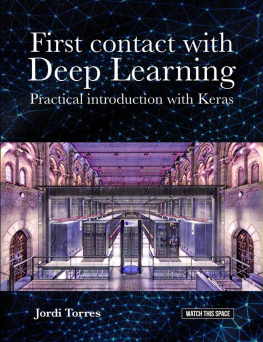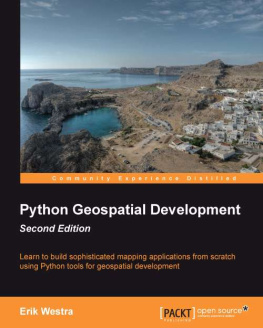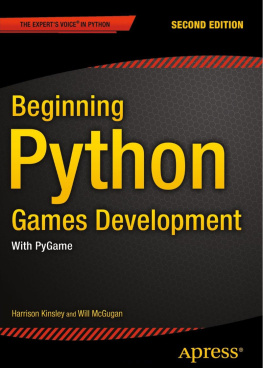Marto Torres - PYTHON DEVELOPMENT
Here you can read online Marto Torres - PYTHON DEVELOPMENT full text of the book (entire story) in english for free. Download pdf and epub, get meaning, cover and reviews about this ebook. year: 2021, publisher: UNKNOWN, genre: Computer. Description of the work, (preface) as well as reviews are available. Best literature library LitArk.com created for fans of good reading and offers a wide selection of genres:
Romance novel
Science fiction
Adventure
Detective
Science
History
Home and family
Prose
Art
Politics
Computer
Non-fiction
Religion
Business
Children
Humor
Choose a favorite category and find really read worthwhile books. Enjoy immersion in the world of imagination, feel the emotions of the characters or learn something new for yourself, make an fascinating discovery.
- Book:PYTHON DEVELOPMENT
- Author:
- Publisher:UNKNOWN
- Genre:
- Year:2021
- Rating:5 / 5
- Favourites:Add to favourites
- Your mark:
- 100
- 1
- 2
- 3
- 4
- 5
PYTHON DEVELOPMENT: summary, description and annotation
We offer to read an annotation, description, summary or preface (depends on what the author of the book "PYTHON DEVELOPMENT" wrote himself). If you haven't found the necessary information about the book — write in the comments, we will try to find it.
PYTHON DEVELOPMENT — read online for free the complete book (whole text) full work
Below is the text of the book, divided by pages. System saving the place of the last page read, allows you to conveniently read the book "PYTHON DEVELOPMENT" online for free, without having to search again every time where you left off. Put a bookmark, and you can go to the page where you finished reading at any time.
Font size:
Interval:
Bookmark:
About the Author xiAbout the Technical Reviewers xiiiAcknowledgments xvIntroduction xvii
iii
Summary 48
Additional resources 49
Summary 99
Additional resources 100
Summary 144Additional resources 144
Error handling 157
Summary 180
Additional resources 181
Tidying up 239
Summary 244
Additional resources 245
Summary 280Additional resources 280
Summary 343
Additional resources 343
Summary 395
Additional resources 395
Summary 451
Additional resources 452
Summary 489
Additional resources 489
Summary 539
Additional resources 540
In this chapter, we will explore the different ways that you can experiment with whatdifferent Python functions do and when is an appropriate time to use those differentoptions. Using one of those methods, we will build some simple functions to extract thefirst pieces of data that we will be aggregating and see how to build those into a simplecommand-line tool.
During any Python project, from something that youll spend a few hours developing toprojects that run for years, youll need to prototype functions. It may be the first thingyou do, or it may sneak up on you mid-project, but sooner or later, youll find yourself inthe Python shell trying code out.
There are two broad approaches for how to approach prototyping: either running apiece of code and seeing what the results are or executing statements one at a time andlooking at the intermediate results. Generally speaking, executing statements one by oneis more productive, but at times it can seem easier to revert to running a block of code ifthere are chunks youre already confident in.
The Python shell (also called the REPL for Read, Eval, Print, Loop) is most peoplesfirst introduction to using Python. Being able to launch an interpreter and typecommands live is a powerful way of jumping right into coding. It allows you to runcommands and immediately see what their result is, then adjust your input withouterasing the value of any variables. Compare that to a compiled language, where thedevelopment flow is structured around compiling a file and then running the executable.There is a significantly shorter latency for simple programs in interpreted languages likePython.
The strength of the REPL is very much in trying out simple code and getting an intuitiveunderstanding of how functions work. It is less suited for cases where there is lots of flowcontrol, as it isnt very forgiving of errors. If you make an error when typing part of a loopbody, youll have to start again, rather than just editing the incorrect line. Modifyinga variable with a single line of Python code and seeing the output is a close fit to anoptimal use of the REPL for prototyping.
For example, I often find it hard to remember how the built-in functionfilter(...)works. There are a few ways of reminding myself: I could look at the documentationfor this function on the Python website or using my code editor/IDE. Alternatively, Icould try using it in my code and then check that the values I got out are what I expect,or I could use the REPL to either find a reference to the documentation or just try thefunction out.
In practice, I generally find myself trying things out. A typical example looks like thefollowing one, where my first attempt has the arguments inverted, the second remindsme that filter returns a custom object rather than a tuple or a list, and the third remindsme that filter includes only elements that match the condition, rather than excludingones that match the condition.
>>> filter(range(10), lambda x: x == 5)Traceback (most recent call last):
File "", line 1, in
TypeError: 'function' object is not iterable
>>> filter(lambda x: x == 5, range(10))
>>> tuple(filter(lambda x: x == 5, range(10)))
(5,)
NoteThe built-in function help(...) is invaluable when trying to understandhow functions work. As filter has a clear docstring, it may have been even morestraightforward to callhelp(filter) and read the information. However, whenchaining multiple function calls together, especially when trying to understandexisting code, being able to experiment with sample data and see how theinteractions play out is very helpful.
If we do try to use the REPL for a task involving more flow control, such as thefamous interview coding test question FizzBuzz (Listing 1-1), we can see its unforgivingnature.
Listing 1-1. fizzbuzz.py a typical implementationfor num in range(1, 101):
val = ''
if num % 3 == 0:
val += 'Fizz'
if num % 5 == 0:
val += 'Buzz'
if not val:
val = str(num)
print(val)
>>> for num in range(1, 101):
...print(num)
...
1
.
.
.
98
99
100
>>> for num in range(1, 101):
...if num % 3 == 0:
...print('Fizz')
...else:
...print(num)
...
1
.
.
.
98
Fizz 100
Every time we do this, we are having to reenter code that we entered before,sometimes with small changes, sometimes verbatim. These lines are not editable oncetheyve been entered, so any typos mean that the whole loop needs to be retyped.
You may decide to prototype the body of the loop rather than the whole loop, tomake it easier to follow the action of the conditions. In this example, the values of nfrom 1 to 14 are correctly generated with a three-way if statement, withn=15 being thefirst to be incorrectly rendered. While this is in the middle of a loop body, it is difficult toexamine the way the conditions interact.
This is where youll find the first of the differences between the REPL and a scriptsinterpretation of indenting. The Python interpreter has a stricter interpretation of howindenting should work when in REPL mode than when executing a script, requiring youto have a blank line after any unindent that returns you to an indent level of 0.
>>> num = 15
>>> if num % 3 == 0:
...print('Fizz')
... if num % 5 == 0:
if num % 5 == 0:
^
SyntaxError: invalid syntax
In addition, the REPL only allows a blank line when returning to an indent level of 0,whereas in a Python file it is treated as an implicit continuation of the last indent level.Listing 1-2 (which differs from Listing 1-1 only in the addition of blank lines) works wheninvoked aspython fizzbuzz_blank_lines.py.
Listing 1-2. fizzbuzz_blank_lines.pyfor num in range(1, 101):
val = ''
if num % 3 == 0:
val += 'Fizz'
if num % 5 == 0:
val += 'Buzz'
val = str(num)
print(val)
However, typing the contents of Listing 1-2 into a Python interpreter results in thefollowing errors, due to the differences in indent parsing rules:
>>> for num in range(1, 101):
...val = ''
...if num % 3 == 0:
...val += 'Fizz'
...if num % 5 == 0:
...val += 'Buzz'
...
>>>if not val:
File "", line 1
if not val:
^
IndentationError: unexpected indent
>>>val = str(num)
File "", line 1
val = str(num)
^
IndentationError: unexpected indent
>>>
>>>print(val)
File "", line 1
print(val)
^
Its easy to make a mistake when using the REPL to prototype a loop or conditionwhen youre used to writing Python in files. The frustration of making a mistake andhaving to reenter the code is enough to undo the time savings of using this method overa simple script. While it is possible to scroll back to previous lines you entered usingthe arrow keys, multiline constructs such as loops are not grouped together, making itvery difficult to re-run a loop body. The use of the>>> and... prompts throughout thesession also makes it difficult to copy and paste previous lines, either to re-run them orto integrate them into a file.
Font size:
Interval:
Bookmark:
Similar books «PYTHON DEVELOPMENT»
Look at similar books to PYTHON DEVELOPMENT. We have selected literature similar in name and meaning in the hope of providing readers with more options to find new, interesting, not yet read works.
Discussion, reviews of the book PYTHON DEVELOPMENT and just readers' own opinions. Leave your comments, write what you think about the work, its meaning or the main characters. Specify what exactly you liked and what you didn't like, and why you think so.








